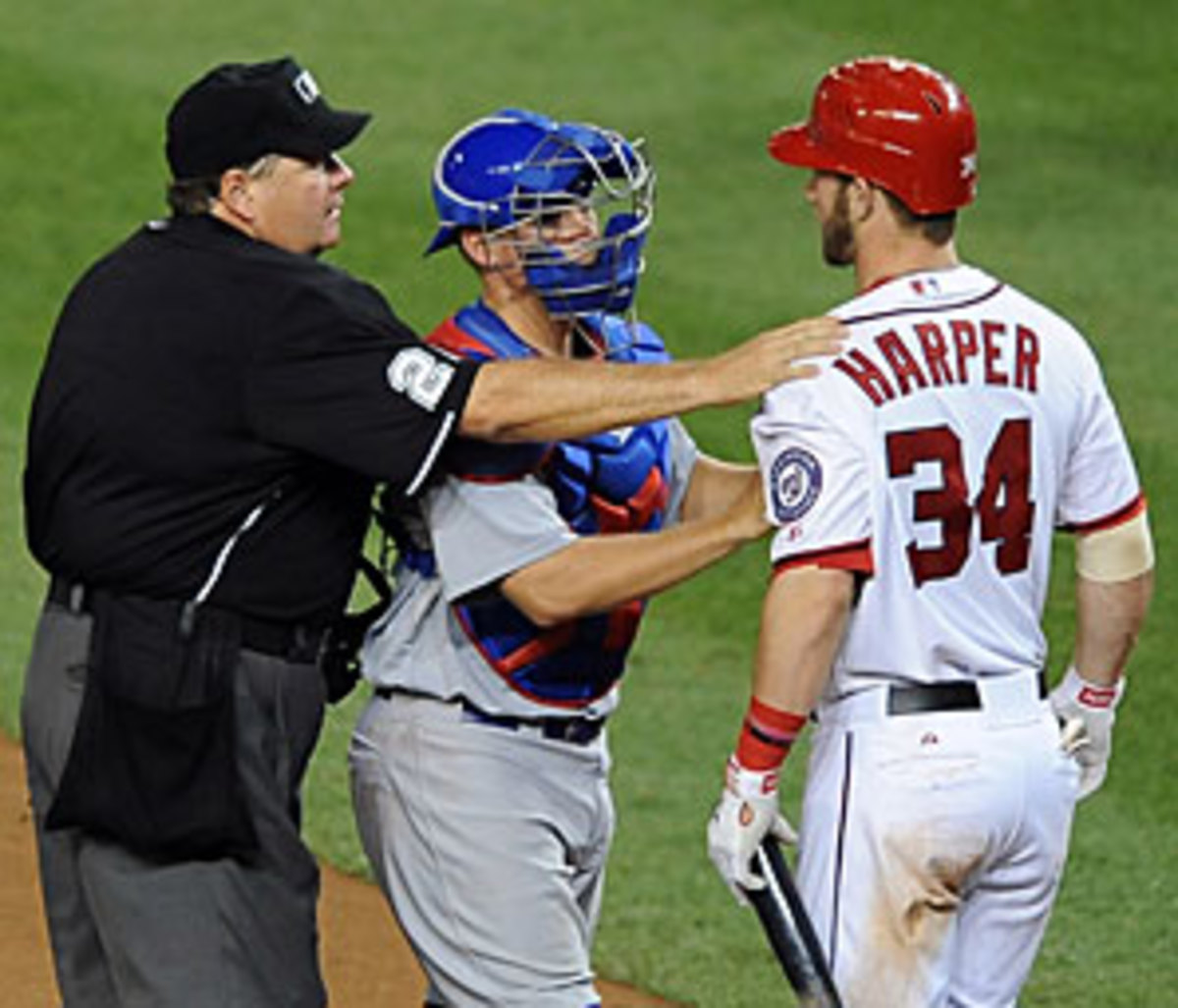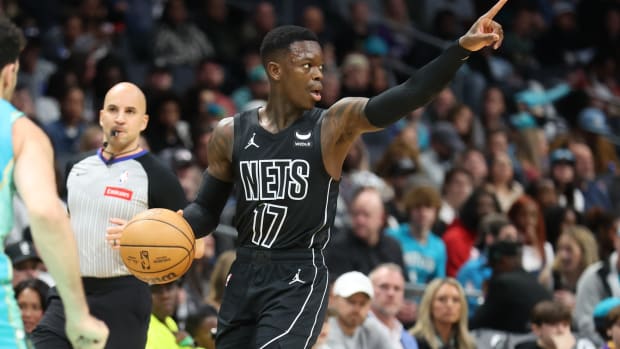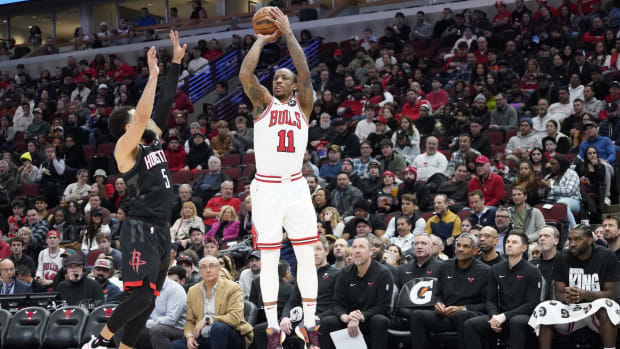
Cubs' wanna-be tough guys embarrass sport and themselves
That's right: the fifth inning. Though you may not know it sometimes by the way the Cubs play, this is not Williamsport. We play nine innings in big boy baseball. Apparently the Cubs think you're not supposed to play hard against them when they are down five with four turns at bat still remaining.
So a bunch of Cubs, especially coach Jamie Quirk, whined enough about it to empty the benches. And self-appointed sheriffs-for-a-day Castillo and Clevenger decided they would take it a step further. Castillo threw his first pitch at Harper, the next batter he faced. Clevenger didn't bother to move his glove even a bit to try to catch it. He immediately got up and thrust his body into Harper -- straight out of Tough Guy 101.
Castillo has an ERA that looks like somebody's birthday: 10.22. He walks almost six batters every nine innings. The point is, when he throws at Harper he can't be exactly sure where the baseball is going. He is just as likely to break Harper's hand as he to "send a message." (Cue the scary music here.) The Nationals will be playing in the postseason. Harper is one of their key players and, of import in a different way, one of the most marketable players in baseball. And somebody named Lendy Castillo is going to put him out of action all in the name of being macho?
It's not macho, partner. It's stupid. There's a place in baseball for upholding the unwritten rules of the game, but this wasn't it -- not by a long shot. Sure, the Cubs were frustrated about the Nationals whacking 14 home runs in three nights against them. But they ought to try another tactic than endangering the health of opponents who actually have something to play for: try executing a few quality pitches.
Castillo, Clevenger and manager Dale Sveum all are due heavy fines and suspensions for such stupidity.
On Sunday Zach Britton will take the ball for the Orioles against the Yankees with what seemed like an unlikely label when he spent the first half of the season in the minors trying to get his shoulder right: pennant race stopper. Since Aug. 7, the Orioles are 5-0 when Britton starts, including 3-0 after losses. The story of how Britton is impacting an unexpected race in Baltimore hints at why the Orioles are about way more than dumb luck in one-run games.
Under general manager Dan Duquette, manager Buck Showalter, pitching coach Rick Adair and organizational pitching adviser Rick Peterson, Baltimore has come up with an integrated system to get the most out of what appeared to be underwhelming starting pitching. The Orioles are one of 11 teams this year to use 11 or more starting pitchers, but they are one of only three of those teams with a winning record. (The White Sox and Rangers are the others.) Britton is one example of how Baltimore has not only survived injuries, but also improved its rotation as the season goes deep into its sixth month.
Britton, 24, began the year on the disabled list with an impingement in his left shoulder. The Orioles sent him to work with Peterson, a cutting edge thinker who began spring training by setting up biomechanical analysis cameras and computers in a covered batting cage so he could get baseline reads on Baltimore pitchers. The analysis showed that Britton suffered from unusually tight hips. The Orioles began tweaking his conditioning program to open up his hips.
On rehab assignment for his sore shoulder, Britton made several mechanical fixes with Peterson. For instance, he moved to the third base side of the rubber to get his sinker to the outside corner against righthanders easier and with more deception; it looked like a middle-of-the-plate strike now before diving outside the zone, as opposed to a ball that hitters ruled out when he threw it from the first-base side.
Also, Peterson had Britton throw some pitches with his eyes closed, a drill in which Britton discovered how hard he had been working his front side, especially to get the ball to his glove side of the plate. By understanding how his body was moving through space -- as well as working on drills such as long toss and throwing uphill on the back part of the mound -- Britton increased the length of his stride by 12 inches, an astounding improvement, especially done in-season.
The result is the Orioles now have a healthy, hot pitcher down the stretch. In his past four starts Britton is 4-0 with a 0.94 ERA and 29 strikeouts in 28 2/3 innings.
Britton isn't the only success story. Chris Tillman, who entered this season with a 5.58 ERA, is 7-2 with a 3.39 ERA in 11 starts. Jake Arrieta, who was optioned to the minors in July with a 6.13 ERA, posted a 1.82 ERA in his last four Triple-A starts before the Orioles brought him back for the stretch. Jason Hammel, thanks to Adair enrolling him in a spring School of Sinkers, is throwing groundballs at a career-best rate.
And 19-year-old phenom Dylan Bundy, under a disciplined innings program designed by Peterson, is still throwing the ball effectively into September. He won his Double-A playoff start Wednesday with six innings of one-run ball and seven punchouts. Bundy has thrown 109 2/3 innings this year. He is 10-3 with a 2.05 ERA, 126 strikeouts and only 29 walks. Bundy is scheduled to make another playoff start, and though the Orioles don't have him ticketed to help the big league club this month, he could force his way into the picture with another good start.
Many surprise contenders begin to fade when their starting pitchers hit a wall. The Orioles' starters have improved as the season has worn on. After a first half in which the starters were 28-34 with a 4.77 ERA, they are 25-16 with a 4.15 ERA in the second half. That improvement has nothing to do with luck.
Until 2007, baseball never had seen a second baseman strike out 160 times in back-to-back seasons. But then Dan Uggla did it (2007-08), and now Danny Espinosa of Washington is just three whiffs from joining him, and Kelly Johnson of Toronto is just 19 punchouts from joining both of them.
"Strikeouts are probably the single biggest change in the game and how its played, certainly going back to the game of [Joe] DiMaggio," said one executive.
Pitchers are setting all kinds of whiff records. The Yankees won a game Wednesday in which they struck out 15 times -- only the third such win in franchise history. (The others came in 1997 and 2010.) It's like comparing driving yardage in golf today to the days of persimmon drivers. You have to recalculate what "a lot of strikeouts" means, which is what the Cubs are doing with 23-year-old centerfielder Brett Jackson.
Jackson has struck out 45 times in 88 major league at-bats -- or more than half the time. Including his Triple-A at-bats, Jackson has whiffed 203 times this year. Is that a problem? Not necessarily. Jackson still is considered by the Cubs to be a top prospect. They are prepared to live with him striking out 200 times a year, as long as he hits no worse than .270 (he's a career .282 hitter in the minors) and takes his walks (his minor league OBP is .379). They did tweak his mechanics a bit recently, giving him a leg kick to generate more power, but his swing remains a long one.
This truly is a different game. By the time DiMaggio struck out 200 times, he had played seven years, made seven All-Star teams and won two MVP awards.


































